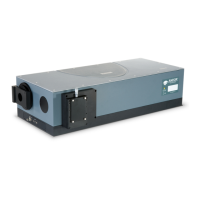The Slit Drive Control is used to control the Motorised Slit Assembly. The slits are used to control the amount of
incident light that enters the spectrograph. The width can be varied between 10μm and 2500μm (in steps of 2.5μm). The
slit height may be altered by interchanging optional bafe plates (attached to the slit assembly using 5x M2 cross-head
screws). The system is supplied with a standard 4mm high x 6mm wide rectangular aperture bafe plate but there are
also 8mm and 14mm high options available. A 15mm diameter circular aperture is also available. When using optical
bres, ensure that the bre is long enough to reach the slits through the bafe. If additional bafe options are required
please contact your nearest Andor representative.
In addition to controlling the level of illumination, the slit width also affects the resolution of the acquired data. There is a
trade-off between resolution and throughput. The narrower and shorter the slit, the higher the achievable resolution, but
at the expense of throughput. As a general rule, it is best if the slit width is set as narrow as possible while still achieving
the required throughput. If the signal is too weak the slit width should then be increased.
The slit width can be set as follows:
1. Type a new value into the slit width edit box and press Enter or click Set.
2. Position the cursor over the grey “blade” area of the slit graphic. Then click and drag the edges of the slit in the
graphic.
As you drag the blade the displayed slit width changes to reect the selected width. The slit drive will drive to the new
width value when the mouse button is released.
The minimum and maximum operating values of the motorised slit are 10 and 2500 microns, respectively. If a slit width
input is outside of this range the system defaults to the nearest limit value.
The mechanism may be reset via the Reset button and selecting the Reset Slit option. On completion of a ‘reset’ the slit
width will default to 10 microns.
WARNING: If using the Wide Aperture Slit, do not perform adjustments when the plunger is fully open to prevent
possible damage driving the motor against the end-point.

